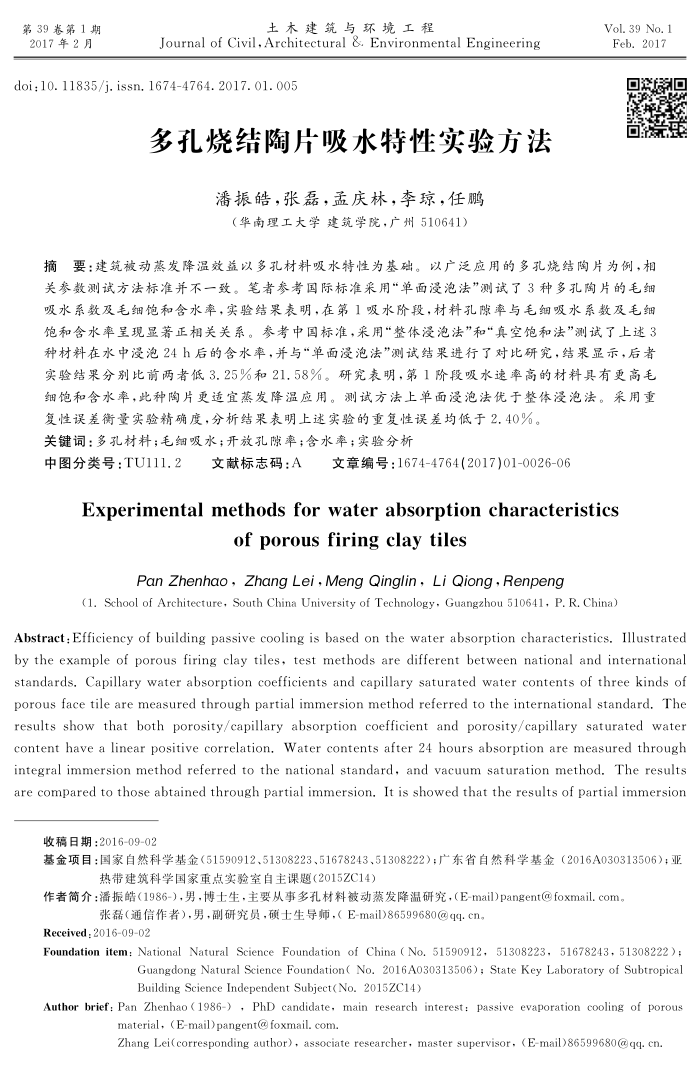您当前的位置:首页>论文资料>多孔烧结陶片吸水特性实验方法
内容简介
 第39卷第1期 2017年2月
第39卷第1期 2017年2月土木建筑与环境工程
Journal of Civil,Architectural &. Environmental Engineering
doi:10.11835/j.issn.1674-4764.2017. 01.005
多孔烧结陶片吸水特性实验方法
潘振皓,张磊,孟庆林,李琼,任鹏(华南理工大学建筑学院,广州510641)
Vol. 39 No. 1 Feb.2017
回口
摘要:建筑被动蒸发降温效益以多孔材料吸水特性为基础。以广泛应用的多孔烧结陶片为例,相关参数测试方法标准并不一致。笔者参考国际标准采用“单面浸泡法”测试了3种多孔陶片的毛细吸水系数及毛细饱和含水率,实验结果表明,在第1吸水阶段,材料孔隙率与毛细吸水系数及毛细
种材料在水中漫泡24h后的含水率,并与“单面漫泡法”测试结果进行了对比研究,结果显示,后者实验结果分别比前两者低3.25%和21.58%。研究表明,第1阶段吸水速率高的材料具有更高毛细饱和含水率,此种陶片更适宜蒸发降温应用。测试方法上单面浸泡法优于整体浸泡法。采用重
复性误差衡量实验精确度,分析结果表明上述实验的重复性误差均低于2.40%。关键词:多孔材料;毛细吸水;开放孔隙率;含水率;实验分析
中图分类号:TU111.2
文献标志码:A
文章编号:1674-4764(2017)01-0026-06
Experimental methods forwaterabsorption characteristics
of porousfiring claytiles
PanZhenhao,ZhangLei,Meng Qinglin,LiQiong,Renpeng
(1. School of Architecture, South China University of Technology. Guangzhou 510641, P. R. China)
Abstract: Efficiency of building passive cooling is based on the water absorption characteristics. Illustrated by the example of porous firing clay tiles, test methods are different between national and international standards. Capillary water absorption coefficients and capillary saturated water contents of three kinds of porous face tile are measured through partial immersion method referred to the international standard. The results show that both porosity/capillary absorption coefficient and porosity/capillary saturated water content have a linear positive correlation. Water contents after 24 hours absorption are measured through integral immersion method referred to the national standard, and vacuum saturation method. The results are compared to those abtained through partial immersion. It is showed that the results of partial immersion
收稿日期:2016-09-02
基金项目:国家自然科学基金(5159091251308223、51678243、51308222);广东省自然科学基金(2016A030313506);亚
热带建筑科学国家重点实验室自主课题(2015ZC14)
作者简介:潘振皓(1986-),男.博士生,主要从事多孔材料被动蒸发降温研究,(E-mail)pangentfoxmail.com,
张磊(通信作者),男,副研究员,硕士生导师,(E-mail)86599680@qq.cn。
Received:2016-0902
Foundation item:National Natural Science Foundation of China(No.51590912,51308223,51678243,51308222);
Guangdong Natural Science Foundation( No. 2016A030313506); State Key Laboratory of Subtropica Building Science Independent Subject(No. 2015ZC14)
Author brief: Pan Zhenhao (1986-) , PhD candidate. main research interest: passive evaporation cooling of porous
material, (E-mail)pangent@foxmail. com
Zhang Lei(corresponding author), associate researcher, master supervisor, (E-mail)86599680@qq. cn